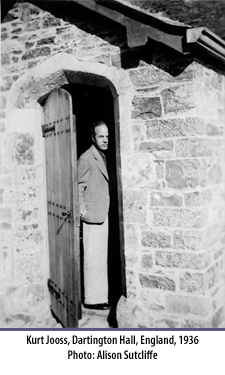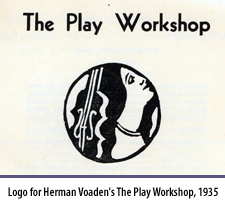| |||||||

![]()
 Sutcliffe's experiences at The Met came in handy when she was asked to choreograph the dances for the Toronto Grand Opera Association's production of Georges Bizet's Carmen at Eaton Auditorium on June 4, 1935. Toronto Daily Star critic Augustus Bridle describes her work: "One of the most effective novelties was the small ballet of duo-dancers, flower-girls and Farandole festal dancers; a reflection from Miss Alison Sutcliffe's experience in the 'Met' ballet." While Bridle was critical of some of the singing, overall, he felt the production was better than the professional one by the touring San Carlo company of New York. He writes:
Sutcliffe's experiences at The Met came in handy when she was asked to choreograph the dances for the Toronto Grand Opera Association's production of Georges Bizet's Carmen at Eaton Auditorium on June 4, 1935. Toronto Daily Star critic Augustus Bridle describes her work: "One of the most effective novelties was the small ballet of duo-dancers, flower-girls and Farandole festal dancers; a reflection from Miss Alison Sutcliffe's experience in the 'Met' ballet." While Bridle was critical of some of the singing, overall, he felt the production was better than the professional one by the touring San Carlo company of New York. He writes:
The chorus had glorious vitality of tone. The mob movements were done with fine regard for rhythmic and mass-motion effects. Tableau groups were artistically built up. Costumes and uniforms were well designed for striking ensemble against scenery gorgeously contrived to make a small stage suggest great depth of color, mass and perspective.
He concluded his review with: "Judged by this production, grand opera is now artistically rooted in Toronto."
By contrast, Bridle's Globe counterpart, Lawrence Mason, described the evening's entertainment as "a performance which fell considerably short of professional standards, but which had some merits if leniently viewed as an amateur effort." He continues to say that the L'Arlesienne Suite was used to "display some very amateur dancing. The orchestra, which had a bad evening in general, made particularly rough weather of this suite." An anonymous reviewer in the Telegram had high praise describing the production as "brilliant". Sutcliffe used dancers she had worked with many times before including Bettina Byers, Helen Richardson, Gladys Schnick and Margaret Craigie. Sutcliffe's friend Fred Manning interpreted the role of "Escamillo" but all critics felt that his performance fell a bit short of his usual abilities.
By July 1935, Sutcliffe was on board the Europa again bound for England to study with Kurt Jooss at Dartington Hall. Bettina Byers made the trip as well as musicians from the Conservatory including Winnifred and Ettore Mazzoleni and Jean Ross MacMillan. MacMillan wrote a little poem for Sutcliffe in a card filled with autographs from the boat ride:
There was a danseuse called Sutclova
Whose breakfast and bath were soon ova
She took them together in all sorts of weather
Two rolls and a little Turnova.
 Kurt Jooss had been a student of Rudolf Laban, the man who initiated the movement form Ausdrucktanz, also referred to as German Expressionist dance. Jooss left Germany when the Nazi Party told him that he could not have Jews in his company; he resettled in England where he and another Laban student, Sigurd Leeder, set up a school at Dartington Hall, where the Jooss Ballet was also based. One of his most famous works is the anti-war themed The Green Table. Sutcliffe's teaching notes reveal incorporation of her studies with both Kurt Jooss and Mary Wigman, as well as the principles of Rudolf Laban's work that she would have been exposed to through these teachers. Notes from the 1930s indicate that her classes included a "Wigman warm up", a "choreutik study", "Jooss gravitational leap", improvisations and rhythmic studies. Photographs give evidence that she also taught Labanotation to her older students - this was the system for recording dance developed by Laban and which is still in wide use today. Her time in New York also presents itself in her teaching as she includes exercises based on the Martha Graham technique.
Kurt Jooss had been a student of Rudolf Laban, the man who initiated the movement form Ausdrucktanz, also referred to as German Expressionist dance. Jooss left Germany when the Nazi Party told him that he could not have Jews in his company; he resettled in England where he and another Laban student, Sigurd Leeder, set up a school at Dartington Hall, where the Jooss Ballet was also based. One of his most famous works is the anti-war themed The Green Table. Sutcliffe's teaching notes reveal incorporation of her studies with both Kurt Jooss and Mary Wigman, as well as the principles of Rudolf Laban's work that she would have been exposed to through these teachers. Notes from the 1930s indicate that her classes included a "Wigman warm up", a "choreutik study", "Jooss gravitational leap", improvisations and rhythmic studies. Photographs give evidence that she also taught Labanotation to her older students - this was the system for recording dance developed by Laban and which is still in wide use today. Her time in New York also presents itself in her teaching as she includes exercises based on the Martha Graham technique.
Toronto classes in ballet, Spanish and modern dance resumed on September 16. In the late fall, she worked with actor, teacher and director Josephine Barrington on a playlet called The Fairy Riddle. Barrington ran a juvenile theatre company from 1931 to approximately 1948 called Josephine Barrington's Juveniles. She had graduated from the Margaret Eaton School of Literature and Expression in 1921 and became an accomplished acting and voice teacher in Toronto while also acting in various summer theatre companies such as John Holden's Actors' Colony in Bala, the International Players in Kingston, Peterborough Summer Theatre and Melody Fair musicals in Toronto. Barrington had also danced with Sutcliffe in the recitals of Mildred Marsh and Winnifred Fax in the mid-1920s. Sutcliffe regularly attended the Juveniles' productions as some of her students, including the Davis children, were peformers in the company. Barrington was often brought up to the Davis' summer house in the Muskokas to work with all the Davis cousins in staging plays - this formative experience was surely influential as Murray, Donald and Barbara formed the Straw Hat Players in 1948, which toured Muskoka during the summers. For The Fairy Riddle, which ran as part of the annual Christmas pantomime at Hart House Theatre, Sutcliffe did the choreography. The Fairy Riddle featured an eleven-year-old Lloyd Bochner. Bochner performed in several of Barrington's productions as well as those at Hart House Theatre. He later acted in the Stratford Festival for six seasons and in early CBC television shows; however, most of his career was spent in Hollywood where he was an accomplished character actor.
 The winter of 1936 involved a couple of collaborations with writer/director Herman Voaden. Voaden was an English teacher at Central High School of Commerce in Toronto's west end; he was also the innovative leader of a group called The Play Workshop. According to house programs, the aims of The Play Workshop were, "To encourage the writing of Canadian drama. To experiment with new production techniques, and in particular to explore the possibilities of combining the other arts with the drama in a new composite theatral language." The members of the group were divided into two parts: the playwriting students met on Monday nights and the production students met on Wednesday nights and rehearsals were held on Tuesday and Thursday evenings. The classes were regular adult education classes under the sponsorship of the Toronto Board of Education. Voaden is responsible for creating a theatrical form called Symphonic Expressionism. Influenced by German Expressionist dramatists Ernst Toller and George Kaiser, Voaden's symphonic expressionist theatre incorporated music, dance, dialogue, lighting and choric voices. During one of his study trips to Germany in the early 1930s, he spent several weeks studying with choreographer Kurt Jooss. Considering Sutcliffe's reverence for German Expressionist dance artists such as Jooss, Harald Kreutzberg and Mary Wigman, it makes sense that she would find a kindred spirit in Voaden and his approach.
The winter of 1936 involved a couple of collaborations with writer/director Herman Voaden. Voaden was an English teacher at Central High School of Commerce in Toronto's west end; he was also the innovative leader of a group called The Play Workshop. According to house programs, the aims of The Play Workshop were, "To encourage the writing of Canadian drama. To experiment with new production techniques, and in particular to explore the possibilities of combining the other arts with the drama in a new composite theatral language." The members of the group were divided into two parts: the playwriting students met on Monday nights and the production students met on Wednesday nights and rehearsals were held on Tuesday and Thursday evenings. The classes were regular adult education classes under the sponsorship of the Toronto Board of Education. Voaden is responsible for creating a theatrical form called Symphonic Expressionism. Influenced by German Expressionist dramatists Ernst Toller and George Kaiser, Voaden's symphonic expressionist theatre incorporated music, dance, dialogue, lighting and choric voices. During one of his study trips to Germany in the early 1930s, he spent several weeks studying with choreographer Kurt Jooss. Considering Sutcliffe's reverence for German Expressionist dance artists such as Jooss, Harald Kreutzberg and Mary Wigman, it makes sense that she would find a kindred spirit in Voaden and his approach.
In January 1936, Sutcliffe participated in a Play Workshop presentation of three plays. She is credited with assisting in the "settings" for a Loyalist-themed play by Jameson Field called Barent's Son. What this credit means is not exactly clear. The other plays on the bill were Virginia Coyne Knight's The Mighty Mr. Samson about a Russian folk tale, and Voaden's Murder Pattern, which is described in the house program as "An Experiment Toward a Symphonic Theatre". Sutcliffe joined the group again in March for an evening of four plays. She played Juliet in a dance-drama version of Romeo and Juliet. Presumably, she worked with Voaden on developing the movement sequences in the work but her precise role in this regard is not clear. Augustus Bridle describes the work as a "wonderfully tableau'd rhythmic pantomime to scenes from Tschaikowsky's 'Romeo and Juliet'; ten splendidly-charactered dancers doing a continuity of scenes to music from the opera - under direction of Alison Sutcliffe in the role of Juliet. As musicalized, color-lighted pantomime, a remarkable production."
![]()
©2008, Dance Collection Danse
Alison Sutcliffe Exhibition Curator: Amy Bowring
Web Design: Believe It Design Works
Dancers at Jooss-Leeder School, 1936
Rudolf Laban's "icosahedron"



